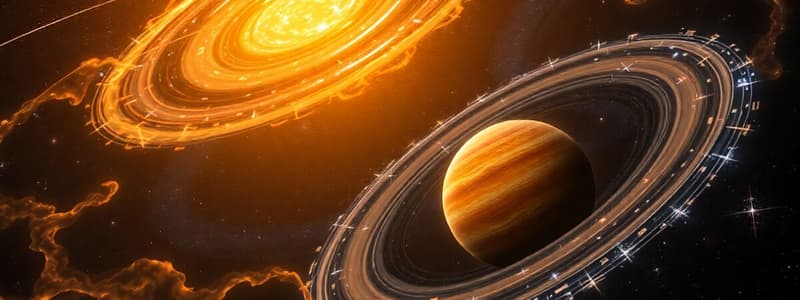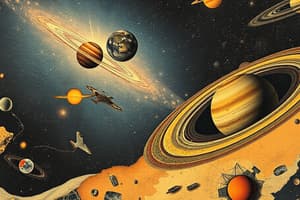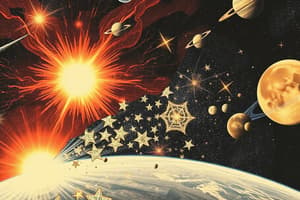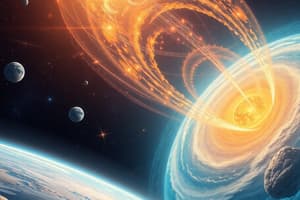Podcast
Questions and Answers
What process explains the growth of terrestrial planets from small particles?
What process explains the growth of terrestrial planets from small particles?
- Gravitational Collapse
- Condensation
- Nebular Shock
- Accretion (correct)
Which theorist proposed that the Solar System formed from a whirlpool-like motion of pre-solar materials?
Which theorist proposed that the Solar System formed from a whirlpool-like motion of pre-solar materials?
- Isaac Newton
- Stephen Hawking
- Rene Descartes (correct)
- Albert Einstein
What is the primary composition of the inner planets according to the content?
What is the primary composition of the inner planets according to the content?
- Dense, rocky, and metallic materials (correct)
- Volcanic and sedimentary substances
- Hydrogen and helium
- Gaseous and icy materials
Which stage involves the clumping of rocky particles to initiate planet formation?
Which stage involves the clumping of rocky particles to initiate planet formation?
How long ago was the Solar System formed?
How long ago was the Solar System formed?
What event is theorized to have occurred 13.8 billion years ago in scientific cosmology?
What event is theorized to have occurred 13.8 billion years ago in scientific cosmology?
Which of the following evidences supports the Big Bang theory?
Which of the following evidences supports the Big Bang theory?
Which of the following problems is associated with cosmological observations?
Which of the following problems is associated with cosmological observations?
What is NOT one of the four basic forces in the universe?
What is NOT one of the four basic forces in the universe?
Who are associated with the Continuous Creation Theory?
Who are associated with the Continuous Creation Theory?
What is the primary composition of gas planets?
What is the primary composition of gas planets?
Where do the formation processes of Jovian planets mainly occur?
Where do the formation processes of Jovian planets mainly occur?
What characterizes the cloud that extends around 750 billion km from the sun?
What characterizes the cloud that extends around 750 billion km from the sun?
What process leads to the accretion of planetesimals in the outer solar system?
What process leads to the accretion of planetesimals in the outer solar system?
What is the distance of the region beyond the planets that is known for originating short-period comets?
What is the distance of the region beyond the planets that is known for originating short-period comets?
What aspect of the universe is presented in the biblical creation story?
What aspect of the universe is presented in the biblical creation story?
Which of the following statements aligns with the concept of timeless creation in religious cosmology?
Which of the following statements aligns with the concept of timeless creation in religious cosmology?
Which philosophical view describes the universe as static and infinite?
Which philosophical view describes the universe as static and infinite?
According to the religious cosmology mentioned, what influences the existence of the universe?
According to the religious cosmology mentioned, what influences the existence of the universe?
What do religious cosmologies and Greek Philosophy seek in their explorations?
What do religious cosmologies and Greek Philosophy seek in their explorations?
What idea does the Heavenly Father's propagation of spirit babies reflect in religious cosmology?
What idea does the Heavenly Father's propagation of spirit babies reflect in religious cosmology?
Which cosmological view asserts that the universe consists of many worlds following the same rhythm?
Which cosmological view asserts that the universe consists of many worlds following the same rhythm?
In which cosmological theory does existence depend on divine actions rather than random events?
In which cosmological theory does existence depend on divine actions rather than random events?
What phenomenon explains the rapid exponential expansion of the universe proposed by Guth and others?
What phenomenon explains the rapid exponential expansion of the universe proposed by Guth and others?
What fundamental concept is associated with the string theory proposed by Veneziano and others?
What fundamental concept is associated with the string theory proposed by Veneziano and others?
Which of the following best describes the interaction of two hyperdimensional branes according to Hugh Everett III's proposal?
Which of the following best describes the interaction of two hyperdimensional branes according to Hugh Everett III's proposal?
According to Einstein's general theory of relativity, what cycle does the universe undergo?
According to Einstein's general theory of relativity, what cycle does the universe undergo?
Which of the following proposed theories suggests that a comet struck the Sun leading to the formation of planets?
Which of the following proposed theories suggests that a comet struck the Sun leading to the formation of planets?
Which of the following statements is true regarding the orbits of planets around the Sun?
Which of the following statements is true regarding the orbits of planets around the Sun?
What does Bode’s Law suggest about the distances of planets from the Sun?
What does Bode’s Law suggest about the distances of planets from the Sun?
In the context of the origin of planets, which explanation involves a rogue star's interaction with the Sun?
In the context of the origin of planets, which explanation involves a rogue star's interaction with the Sun?
Flashcards are hidden until you start studying
Study Notes
Theories on the Origin of the Universe
- Descartes’ Theory: The Solar System formed due to the whirlpool-like motion of pre-solar materials.
- Kant-Laplace Nebula Theory: The Solar System originated from a large cloud of gas and dust called a nebula.
- Formation of the Solar System: Approximately 4.55 billion years ago (Ga), interstellar materials in the Milky Way galaxy underwent stages to form the Solar System.
Inner Planets (Terrestrial Planets)
- Composed of dense, rocky, and metallic materials.
- Formed through collisions and accretion of planetesimals due to gravitational attraction.
- Inner planets include Mercury, Venus, Earth, and Mars.
- Accretion is the process where microscopic particles condense to form large masses, eventually becoming planets.
Outer Planets (Jovian Planets)
- Primarily composed of hydrogen and helium.
- Formed by gas accretion beyond the frost line.
- Outer planets include Jupiter, Saturn, Uranus, and Neptune.
Religious/Mythological Cosmology
- Biblical Creation Story: God created the universe in six days.
- Mormon Cosmology: Creation occurred from existing matter, with God creating the universe.
- Buddhist Cosmology:Existence of the universe is dependent upon the action or karma of its inhabitants; Universe has no beginning and end; Universe consists of a large number of worlds
- Islamic Cosmology: God created the universe BUT teaches to visualize cosmos as a book of symbols for meditation and contemplation to be used for spiritual upliftment
- Hindu Cosmology: Creation is timeless and has no beginning. The are many universes which all follow the same rhythm: creation and dissolution
- Hindu Text: Rigveda (The Cosmic Egg Theory): It described the universe as an oscillating universe in which a cosmic egg (Brahmanda) containing the whole universe expanded out of a single concentrated point (Bindu) and will eventually collapse again.
Greek Philosophy
-
Primordial Universe Theory: Proponent: Anaxagoras :believed in a primordial universe and explained that the original state of the cosmos was a primordial mixture. The mixture was then set to a whirling motion (action of the “nous” or mind), and separated the ingredients.
-
Atomic Universe Theory:
Proponent: Leucippus & Democritus
Believed in an atomic universe
The universe was composed of very small, indivisible particles.
They also believed that the universe is like a giant living body - what happens in one place affects the events that occur elsewhere.
-
Aristotle and Ptolemy: Proposed a geocentric universe where the Earth stayed motionless in the heavens and everything was revolving around it.
-
Principia:
Proponent: Isaac Newton
● Described the universe as a static, steady-state, infinite universe.
● Matter on a large scale is uniformly distributed, and the universe is gravitationally balanced but essentially unstable.
-
Static and Infinite Universe/Gravitational Effects:
-
Theory of Relativity:
Scientific Cosmology
Big Bang Theory
- Proposed by George Lemaitre, the universe originated from a singularity approximately 13.8 billion years ago. This singularity underwent rapid expansion, resulting in matter, energy, time, and space spreading in all directions.
Evidence Supporting the Big Bang Theory
- Galactic Red-Shifts: Observance of galaxies moving away from each other.
- Cosmic Microwave Background Radiation (CMBR): Discovery of faint radiation leftover from the Big Bang.
- Abundance of Light Elements: Presence of hydrogen and helium in the universe.
Problems with the Big Bang Theory
- Monopole Problem: No magnetic monopoles have been observed despite predictions.
- Flatness Problem: The universe's geometry is almost flat, suggesting a specific initial condition.
- Horizon Problem: Evidence suggests that regions of the universe that should be unconnected based on the Big Bang theory must have been in contact in the past.
Steady State Theory
- Proposed by Fred Hoyle, Thomas Gold, and Herman Bondi.
- The universe expands but maintains a constant density due to continuous creation of matter.
Inflationary Theory
- Proposed by Alan Guth, Andrei Linde, Paul Steinhart, and Andy Albrecht.
- A period of rapid exponential expansion in the early universe, driven by repulsive gravity.
- Proposed as a solution to the problems with the Big Bang theory.
String Theory
- Proponents: Gabriele Veneziano, Edward Witten, John Schwarz.
- Fundamental building blocks are strings vibrating at different modes, representing various particle types.
Brane Theory
- Proponents: Hugh Everett III and Bryce DeWitt.
- The universe is formed by the contact of two hyperdimensional objects called branes.
- This theory supports the idea of a "many worlds" structure of the universe.
Big Crunch Theory
- Proponent: Albert Einstein.
- Based on general relativity, the universe expands first, then contracts due to gravity in a perpetual cycle of big bang and big crunch.
Formation of Planets
- Collision Theory by George Buffon: A comet striking the Sun created fragments that formed planets.
- Tidal Theory by James Jeans and Harold Jeffreys: A rogue star passing near the Sun stripped materials from both celestial bodies, forming planets.
Inner Planet Formation
- Condensation of gases to form rocky particles.
- Formation of clumps from these particles.
- Accretion of these clumps to form planetesimals.
- Growth of planetesimals to their limiting sizes.
Outer Planet Formation
- Condensation of gases to form ice particles.
- Formation of clumps from these particles.
- Accretion of these clumps to form planetesimals.
- Growth of planetesimals through further accretion.
Asteroid Belt and Kuiper Belt
- Asteroid Belt: Located between Mars and Jupiter, composed primarily of rock and metal.
- Kuiper Belt: Located beyond Neptune, extending to the edge of the solar system, composed of icy materials and rocks.
Bode's Law
- Describes a pattern in the distances of planets from the Sun.
Features of Planetary Orbits
- Elliptical Shape: Planets have elliptical orbits around the Sun.
- Co-Planarity: All planets orbit in nearly the same plane.
- Counterclockwise Revolution: Planets revolve around the Sun in a counterclockwise direction.
- Counterclockwise Rotation (Except Venus and Uranus): Planets rotate on their axis in a counterclockwise direction, except for Venus and Uranus.
Studying That Suits You
Use AI to generate personalized quizzes and flashcards to suit your learning preferences.




